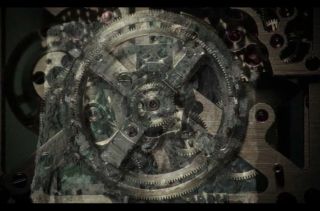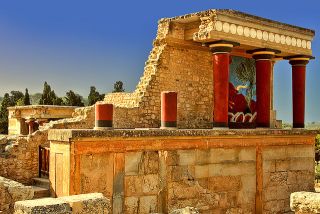
An ancient Greek analogue computer used to predict astronomical positions and eclipses for calendar and astrological purposes decades in advance.
The artifact was retrieved from the sea in 1901, and identified on 17 May 1902 as containing a gear wheel by archaeologist Valerios Stais, among wreckage retrieved from a wreck off the coast of the Greek island Antikythera. The instrument is believed to have been designed and constructed by Greek scientists and has been variously dated to about 87 BC, or between 150 and 100 BC, or to 205 BC, or to within a generation before the shipwreck, which has been dated to approximately 70-60 BC.
The device, housed in the remains of a 34 cm × 18 cm × 9 cm wooden box, was found as one lump, later separated into three main fragments which are now divided into 82 separate fragments after conservation works. Four of these fragments contain gears, while inscriptions are found on many others. The largest gear is approximately 14 centimetres in diameter and originally had 223 teeth.
It is a complex clockwork mechanism composed of at least 30 meshing bronze gears. A team led by Mike Edmunds and Tony Freeth at Cardiff University used modern computer x-ray tomography and high resolution surface scanning to image inside fragments of the crust-encased mechanism and read the faintest inscriptions that once covered the outer casing of the machine.
Detailed imaging of the mechanism suggests that it had 37 gear wheels enabling it to follow the movements of the Moon and the Sun through the zodiac, to predict eclipses and even to model the irregular orbit of the Moon, where the Moon's velocity is higher in its perigee than in its apogee. This motion was studied in the 2nd century BC by astronomer Hipparchus of Rhodes, and it is speculated that he may have been consulted in the machine's construction.
The knowledge of this technology was lost at some point in antiquity, and technological works approaching its complexity and workmanship did not appear again until the development of mechanical astronomical clocks in Europe in the fourteenth century. All known fragments of the Antikythera mechanism are kept at the National Archaeological Museum in Athens, along with a number of artistic reconstructions/replicas of how the mechanism may have looked and worked.
Read also
- The Underwater City of Yonaguni
- The giant stone spheres of Costa Rica
- The Voynich manuscript
- The unfinished obelisk
Comments
You are not allowed to post comments. Please login.
Menu
Gallery
Categories
Who is online
We have 3 guests and 1 user online.












